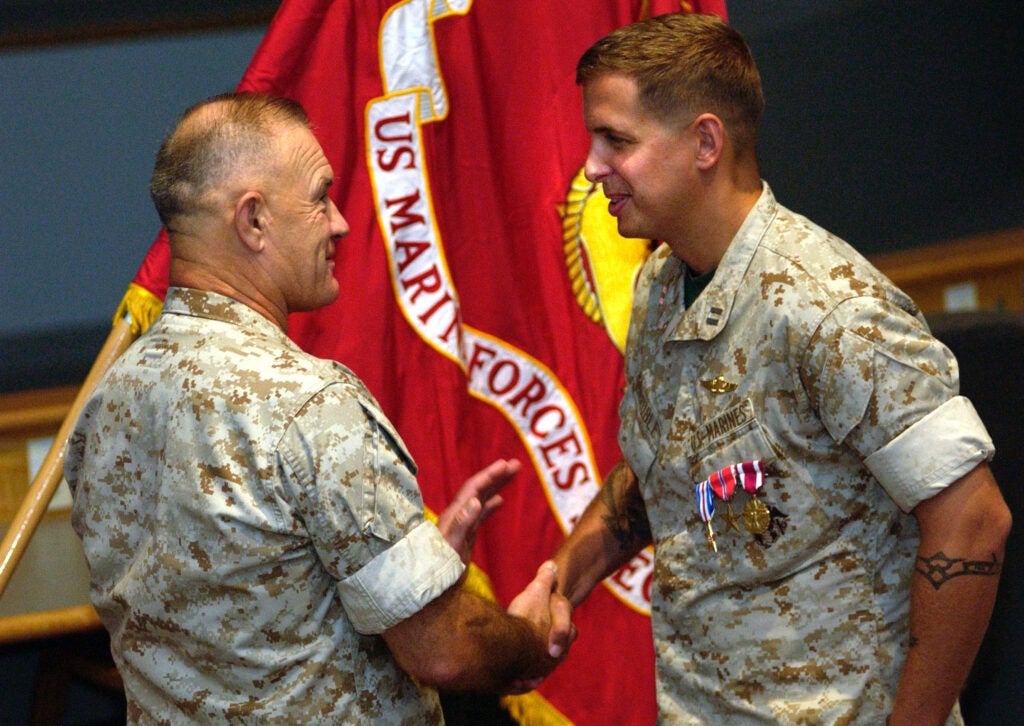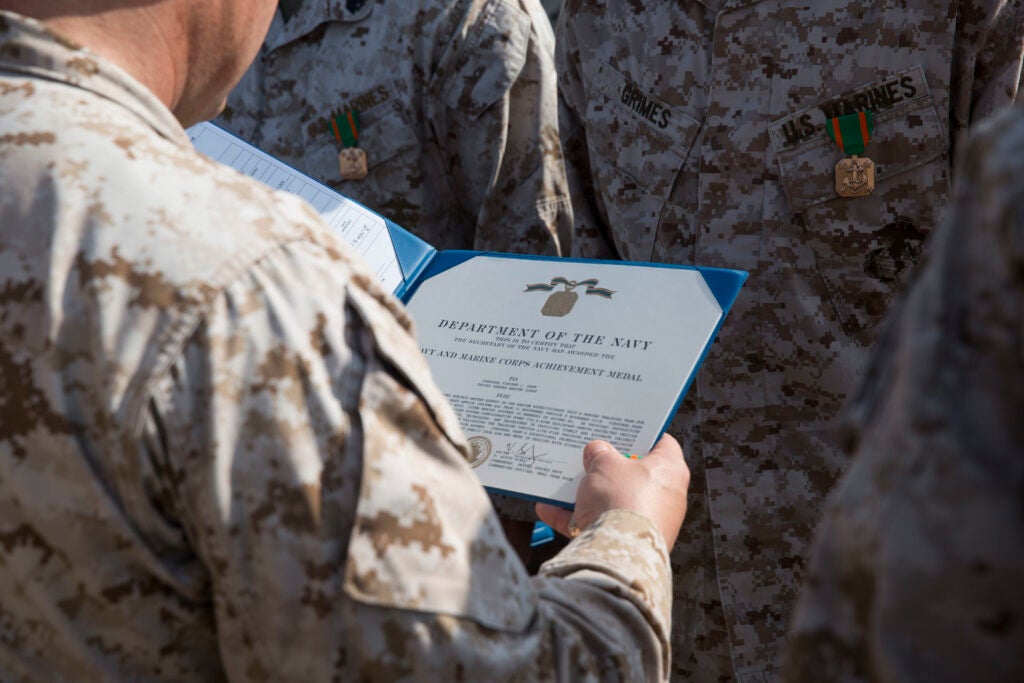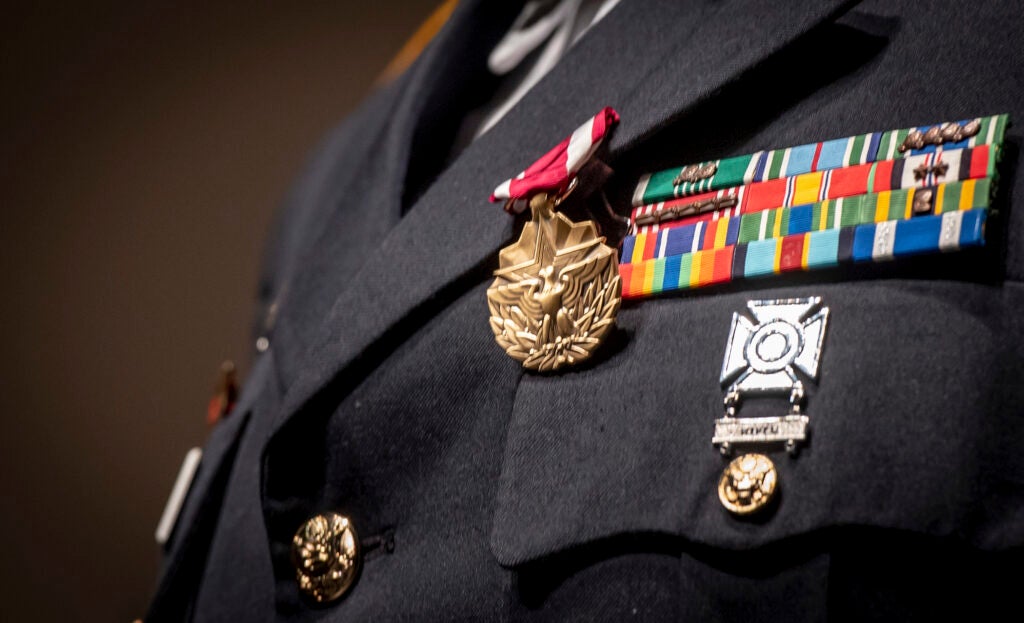It’s that time of year again for the devil dogs across the country. For the past few months, tailor shop lines were out the door, inspections of uniforms only worn a handful of times popped up repeatedly on the training schedule, and the inevitable comparison, perhaps judgment for some, of “chest candy” began in earnest. For the newest Marines, it’s as simple as putting a National Service Defense medal next to a Global War on Terrorism medal in the proper order. But for those having recently changed duty stations or units, there is the scramble to update their awards “stack” with all the new participation trophies the Marine Corps doled out. Although I think the preferred term is the “end of tour” award.
In fact, the Pentagon is so aware that the majority of awards are given at the end of a tour with a unit that they issue an administrative message to warn us all. This year it came out in February, titled “MILITARY AWARDS GUIDANCE FOR THE 2021 PERMANENT CHANGE OF STATION SEASON.” This is how commonplace, for what was long considered the most stringent service branch regarding awards, it has become to give Marines the ol’ “atta boy” or a “thanks for coming out” or even the occasional, “good job not getting fired” award. Come moving season each year, company-grade officers, noncommissioned officers, and Staff Sergeants alike will get their Navy Achievement Medals. Field grade officers, gunnery sergeants, and “Tops” will get their Navy Commendations. Commanders and Sergeants Major will get their Meritorious Service Medals standing in front of their whole unit on the way out the door. And of course, those with eagles or stars on their collars will receive Legions of Merit or Distinguished Service Medals. You can almost picture the Birthday Balls and Marines squeezed into their Dress Blues with their fresh new medals, double-fisting Coors Lights, walking into a ballroom, taking a look at each other’s “stack,” and saying… “Meh.”
It may be a colorful and generic description, but there’s a vein of truth that Marines all tacitly know. The truth is that many awards don’t mean much anymore to the average Marine.
Do any awards matter?

Not all awards are meaningless, of course. That same “stack” at a birthday ball could reasonably be dissected into four categories, two of which still hold strong value to Marines or serve a useful purpose.
Second to none amongst Marines are the combat and valor awards. Medals of Honor, Navy Crosses, Silver Stars, Distinguished Flying Crosses, and any award with a “V” device automatically garner attention and deference from Marines. This is due to strict and tightly controlled requirements to earn such rare and combat-oriented awards. The Combat Action Ribbon has a similar effect, although there has been a diluting of its value in some circles due to a perceived loosening of awarding requirements during Operations Enduring Freedom and Iraqi Freedom. This feeling that the CAR was watered down comes from whole units being blanket issued the ribbon in theater or stories of an IED hitting one vehicle in a convoy and the entire convoy receiving it, rather than it being issued specifically to individuals involved in direct action against the enemy.
The next useful category could best be described as a visual resume. Campaign awards give other service members a condensed overview of where you have been and, to some degree, how long you have served. Our senior-most staff can still be seen with Operation Desert Shield medals, while many career-level Marines have OEF and OIF medals. A limited number of Marines continue to receive the Operation Inherent Resolve medal, while those Marines serving on MEUs may receive a Humanitarian Service Medal for conducting disaster relief. Additionally, you can tally the number of deployments someone has been on by the number of stars on their Sea Service Deployment ribbon or tell if they spent time in Korea by the Korean Defense Service Medal. Ultimately, these awards can give a Marine a sense of someone’s experience level or at least provide common ground when striking up a conversation.
The third category is an odd set of awards that are seemingly neutral in value: unit citations. These can be Presidential, Navy, and Meritorious Unit Citations or various joint awards. Assuming the award isn’t one of the dozens given to a Headquarters or Joint Staff that is patting themselves on the back, these awards can actually take years to approve and requires vigilant monitoring of MARADMIN “Awards Updates” for notification. Some MEUs find themselves receiving awards two or more years after disbanding. For example, according to MARADMIN 114/21 released on March 4, 2021, HMLA-269 is finally receiving a Meritorious Unit Commendation… from 2012. This absurd awarding timeline coupled with a general desire to avoid awkwardly asking about someone’s ribbons relegates these awards to overall neutrality, possibly obsolescence.
Finally, we have the fluff awards. These awards are generally disregarded unless they have a special device, such as the “V” for valor, “R” for remote, or “C” device for effect in a combat area, indicating something out of the ordinary occurred to receive them. These include the NAMs, Navy Comm’s, MSMs, and every brand of medal using the words “Distinguished” or “Superior” in their title. These are the awards that have been so over-issued and watered-down that command photos of our highest officers could be mistaken for old Soviet generals. These are the participation trophies of the military and everyone knows it. But how did they become so diluted that they feel irrelevant?
Is it really a problem?

What would you think if you saw a staff noncommissioned officer or a field grade officer without a personal award? At first, it may seem odd. “How did that happen?” you might ask. Perhaps you may be more direct: “They must have pissed someone off” or “They must not be very good.” Those thoughts don’t come up because the person is actually bad at their job or has an off-putting personality, those thoughts arise because of a learned expectation. We expect that if you stay active duty long enough, you’re bound to eventually get an award. It’s not a question of if they performed well, it’s really just a matter of time and rank. I’d argue this expectation is so developed that matching specific awards with certain ranks is as predictable as following an MOS road map.
This creates a perception that personal awards are less about doing specific noteworthy actions and more about crossing a career threshold without upsetting your superiors along the way. For instance, it has become all too common that if someone does their job adequately over a single tour, just summarize the highlights of their Fitness Reports, add some flourish to the wording, and submit it up the chain. Those individuals may have legitimate “Impact” award-worthy material in that same write-up, but their noteworthy actions get diluted among the rest of the material for their “End of Tour” award. Even more offensive, an individual could deserve a higher level award, but their unit’s awards board imposes its own restrictions on who can earn what. Most commonly, units restrict the maximum level of award an individual can receive based solely on their rank and not their merit.
Perhaps some of this is unintentional. S-1 administrative shops across the fleet are perpetually swamped with policies, programs, pay issues, and other administrivia that are, quite frankly, more important than someone’s personal award. So it stands to reason, the most convenient method with the simplest deadline for ensuring people get awarded is to catch them as they are out-processing. Plus, adding multiple years to the window of the award ensures there is plenty of material to meet the minimum justification. An added kicker of convenience, particularly amongst officers, is that while an individual is writing the form containing a list of responsibilities and accomplishments for their final FITREP, they are perfectly poised, and sometimes asked, to write their own Summary of Action for an award. Now, the Reporting Seniors can more conveniently submit for awards without having to think too critically about what their Marines have done to actually deserve one. They don’t even have to consider the type of award if the unit policy limits awards based on rank. It’s just easier this way. The end result, the “Impact” awards for truly meaningful accomplishment become the drastic minority when compared to the “End of Tour” awards, at least by perception, and the value of personal awards overall continues to tank.
What do we do about it?

Some might say we can fix this by tightening the reins or modifying the awards themselves. For example, in 2017 with MARADMIN 665/17, the Marine Corps added the “C” and “R” devices to better recognize combat-related activities but also chose to clarify Bronze Star criteria. Specifically, it stated that the Bronze Star is to be awarded to those who were “either personally exposed to hostile action, or [were] at significant risk of exposure to hostile action.” This clarification was largely thanks to the excessive issuing of the Bronze Star during OEF and OIF as an end of tour award across all branches, even if the individuals were not actually exposed to or at significant risk of enemy action.
Specifically, between 2002 and 2004, the Marine Corps awarded 701 Bronze Stars, the Air Force awarded 2,425 in total, and the Army issued a ridiculous 17,498 Bronze Stars between the wars in Iraq and Afghanistan. For perspective, the Army is habitually more than double the size of the Corps; at its peak in 2009 the Corps had 203,000 Marines compared to the Army’s 549,000 soldiers. Yet the Army awarded 25 times more Bronze Stars than the Marines. By 2007 the Army would award more than 50,000 non-valor Bronze Stars and almost 1,700 Bronze Stars with a “V.” While the Marine Corps is generally regarded as “stingy” with its combat awards when seeing those numbers, it’s obvious why the Marine Corps would attempt to modify and clarify its combat awards to prevent similar inflation.
However, that example falters as a method of how to fix personal awards since the Bronze Star maintains its original conditions-based restrictions. By simply enforcing and clarifying a very specific set of criteria, the Bronze Star’s clout can be restored and maintained. Non-valor personal awards, on the other hand, have had no such conditions-based requirement and as such are open to expansion and abuse, hence their propensity to be used for End of Tour, “feel good” purposes. If these awards are systemically problematic and prone to inflation, perhaps we shouldn’t be afraid to downsize or outright eliminate our excess and broken programs.
This year we saw the rollout of the Junior Enlisted Performance Evaluation System (JEPES) system for evaluating junior Marines in a far more objective manner than ever before. Implementing JEPES was a decisive step in eliminating the notorious issue of proficiency and conduct score inflation. Historically, whether scores were inflated was entirely up to individual commands and trusting that other commands were holding to the standard as well. Regardless of how well commands across the Corps maintained scoring standards, the concern for and stigma of inflation stuck until the system was eliminated. Like Pros and Cons, it’s time we scrap participation trophies from our culture and focus on awarding Marines truly deserving of recognition, not just because it’s PCS season.
If we are unable to police ourselves and award only to those truly outstanding individuals or for events that deserve accolades, then perhaps we should scrap them altogether. Eliminating excessive awards would alleviate unnecessary paperwork and time spent on awards boards, let alone the amount of time people spend actually writing and screening Summaries of Action and Citations for submission. In addition to lifting the burden on lower command administration, promotion and career boards would no longer be distracted evaluating individuals by how many personal awards they do or don’t have and instead focus on the actual performance of their duties. We, as an organization, are wasting valuable time on meaningless awards that could be better spent elsewhere.
If elimination of awards is too extreme or, more realistically, not feasible as they are governed by a higher Navy authority, then perhaps the next option is to restrict availability. Currently, NAMs are awarded by O-5 level commanders with no limits on quantity. By restricting commanders to a set number in a given fiscal year, it would force not only higher scrutiny by the awarding authority but an increase in the quality of submissions. For higher awards that already have limits on quantity, those restrictions could be tightened further. For instance, should every battalion or squadron commander receive a Meritorious Service Medal for successfully finishing a tour as a commanding officer? What would happen if Regiments or Groups had to recommend top commanders within a set timeframe? Regardless of the specifics, increasing restrictions on how many awards of a given type can be issued within a designated time frame would logically result in commands recognizing the true top performers and begin to return value to personal awards.
Ultimately, we need to honestly evaluate if the current processes of recognizing our Marines are truly value-added. But if the likes of Chesty Puller and Smedley Butler could excel through their careers with less than three non-valor personal awards from the U.S. Military, perhaps going through a career without three NAMs, a Navy Commendation, an MSM, and DSM isn’t too tall of an order.
+++
Capt. Brent “Wheeler” Kreckman is currently the Air Officer for 3rd Battalion, 3rd Marine Regiment with multiple deployments in Central Command and Pacific Command over his 12 years of active service. The opinions expressed are his and do not reflect or represent any official position of his commands, the US Marine Corps, or the Department of Defense.
More great stories on Task & Purpose
Want to write for Task & Purpose? Learn more here and be sure to check out more great stories on our homepage.
